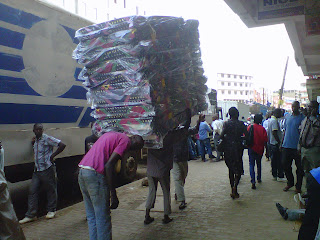Getting to know Kampala
So far my visits to Kampala have been touch and go. This has
been by design as I am not a fan of large cities in developing countries. They
tend to be claustrophobic and a bit too much of a dramatic contrast from my
usual rural living. This combined with the fact that Kampala’s culture is
radically different from the north of Uganda has made me feel out of place with
little motivation to try to understand the cosmopolitan culture. However, forced to kill an entire day waiting for my visa
to be processed, I decided to observe a slice of Kampala and hopefully get a
better feel for the city.
The first thing I want to mention about Kampala is the
congestion. Most urban areas in the world are congested and Kampala is no
different with seemingly every inch covered with people, goods for sale, or a
combination of the two. Kampala is also noted for its large presence of
“boda-bodas” (motorcycles). These can be awfully useful for avoiding the
notorious congestion but are also extremely dangerous for the same reason. Boda
drivers tend to squeeze through small spaces, drive against the flow of
traffic, merge without looking, and often, exhibit all three of these
dangerous behaviors simultaneously. Peace Corps actually bans their volunteers
from using boda-bodas in Kampala, which I thought was over the top, until I
rode my first boda in Kampala.
Still, bodas are an excellent solution to beating the
standstill traffic and always readily available. You can see the video below
for a short, and actually relatively safe and uneventful, boda ride.
I had nearly an entire day to kill in Kampala and decided to
stroll around the downtown area. This area was not the financial district,
rather what appeared to be the main hustling area of Kampala. Laborers ran up
and down the sidewalk with a variety of goods on their heads, semi-trucks
unloaded an even wider variety of goods, and the rows of shops (both brick and
mortar and temporary set ups on the side walk) sold pretty much every variety of
goods you can imagine. I found two vendors selling papaya and sat down on a
bench, which was a lucky find. There wasn’t exactly a lot of open space to rest
so I took advantage of the prime real estate.
I ended up sitting at this spot for about two hours. It was
wedged in between a shop selling shoes (and repairing them) owned by Chinese
and a shop selling handbags and suitcases and in front of the shops, the two
guys selling papya. On the road there were a variety of semi-trucks, some
parked and loading, some unloading. In the time I was there one truck loaded
pillows, Muslim prayer mats and shoes (when I left it was still basically
empty). Who knows where it was headed and what other goods would be loaded
throughout the day? I witnessed a semi-truck unloading luggage and transporting
them to a different location. When I saw laborers stack six suitcases on their
head I thought, “That’s not too bad, I could probably carry them for a block.” Then I saw that they were like those Russian dolls and each suitcase actually
had three suitcases in side of it. Well, maybe it would be an accomplishment
enough just to get it on top of my head.
As soon as I was done being amazed by the suitcase men, a
truck came and unloaded mattresses. Transport of mattresses in developing
countries has always been comical to me since they don’t weigh much though they
take up a large area. Still, it’s impressive when some guy puts nine of them on
his head and walks down the street.
There was a rotating cast of people that shared the bench
with me. Many of them were day laborers and said they were often paid UGX5,000 ($2) for carrying loads. They said it was highly variable depending on the amount of
goods and distance to the delivery location, but most of them seemed to think
it was low paying. And actually, most of them appeared to be loitering and not
in a huge hurry to work and one was certainly drunk. A woman came with some
food that did not look appetizing but smelled amazing. It was a mix of bean and
vegetables with a cut up chapatti inside. It smelled delicious and I
immediately asked the man receiving the food how to get one. He said you had to call a woman and she
would bring the food. He placed an order for me and about 10 minutes later a
woman came with a ceramic bowl. It was UGX2,000 (about $.75) and it was delicious as it was
filling. Apparently there are women who live in the area and they cook up huge
pots of food and deliver on demand. I noticed several of these women in the
area offering a variety of dishes. For comparison sake, a similar dish in a
restaurant would cost about UGX5,000-10,000 ($2-4). While I was dining on my lunch, it
was certainly the time I received the most looks from people passing by.
After my lunch I was thirsty. As if reading my mind, a woman
selling drinks came by. I bought a water and was left feeling very content. I
chit-chatted with the small crew of friends I had made and then moved off.
Although the hustle and bustle certainly did not cease at any point in my time
on the bench, I at least felt like I had the opportunity to stop and soak in
the pace of life in Kampala.






Comments
Post a Comment